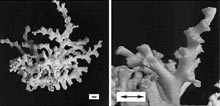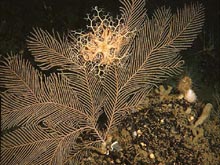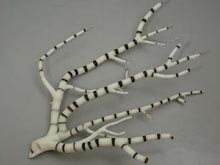Medicines from the Deep Sea: Discoveries to Date
Amy E. Wright, PhD
Co-Principal Investigator, Gulf of Mexico Expedition
Director, Division of Biomedical Marine Research
Harbor Branch Oceanographic Institution
The discovery of novel chemical compounds from deep-sea marine organisms often takes us to new and exciting locations. One of the first steps in planning such an expedition is to thoroughly review the scientific literature about a new target site. This includes reviewing surveys and literature on the biology and geology of a region by environmental consulting firms, government agencies, such as the Minerals Management Service, National Marine Fisheries Service, and U.S. Geological Survey, and various research institutions. This will help us determine whether an area is worth spending precious time and funds to explore.
Our research expeditions have taken us throughout the Caribbean; to the eastern Atlantic, including the Azores, Canary Islands, Cape Verde and western Africa; to the Pacific Ocean, including the Galapagos Islands, Samoa, Papua New Guinea, and Australia; and to the Indian Ocean, to the Seychelles and Thailand. Our target organisms are often associated with hard-bottom habitat and include sponges, octocorals, bryozoans, tunicates, and algae. Detailed bathymetric charts are also useful in determining whether the "right" bottom type is present to provide essential habitat for benthic organisms. Little is known about the deep-sea environment in most of the places we have explored, so we always have to start with our best guess.
Last Summer's Discoveries

Lophelia pertusa is a deep-water coral that forms deep reefs in the Gulf of Mexico and throughout the world. Click image for larger view.
Last summer, our team from Harbor Branch Oceanographic Institution (HBOI) participated in NOAA's Islands in the Stream 2002 Expedition to the South Atlantic Bight, documenting the biodiversity of deep-water reefs on the Blake Plateau. We were the first people ever to dive on most of the sites that we visited with HBOI's Johnson-Sea-Link submersible. Virtually nothing was known about the habitats and we had no idea what to expect. It was exciting to discover a variety of rich habitats with exceptional biodiversity.
On one dive, we discovered a 500-ft-tall pinnacle on the eastern edge of the Blake Plateau that consisted of live bushes of Lophelia coral, sponges, gorgonians, and black coral bushes. Several new species were discovered, along with new records of occurrence of certain sponges and octocorals. During this mission, we took nearly 30 hrs of video footage, as well as 160 underwater and 508 shipboard digital still images of deep-sea marine organisms (some new to science), sampled 23 deep-water sites, and collected more than 189 macroorganism samples for the drug discovery program.
Subsamples of each specimen were stored in our frozen sample repository to allow for chemical analyses and studies on bioactivity. Subsamples were also frozen in our Molecular Genome Archive (preserved for both DNA and RNA extraction), and specimens were cryopreserved ("deep frozen") for follow-up work on microbial isolations and invertebrate cell cultures. Cultures of about 300 microbial isolates derived from the specimens are archived in our Marine Microbial Collection. Logs of our expedition along with background information on our program and the mission summary report (PDF, 2 Mb) can be found on this site.
Marine Targets for Biomedical Research
Over the past quarter-century, more than 10,000 compounds have been reported from marine-derived organisms. These compounds encompass a wide variety of chemical structures including acetogenins, polyketides, terpenes, alkaloids, peptides and many compounds of mixed biosynthesis. A number of excellent books and reviews document the diversity of both structures and bioactivities that have been observed for marine-derived compounds (Faulkner 1984-2002, 1993; Attaway 1993; Carte 1996; Jensen 1996; Fenical 1997). At least 12 marine-derived compounds are currently under clinical investigation for use as anticancer agents. These include ecteinascidin, from the tunicate Ecteinascidia turbinata, which is in Phase III clinical trials; aplidine, from the ascidian Aplidium albicans, which is in Phase II trials; dolastatin, from the sea hare Dolabella auratium, which is in Phase I trials; and bryostatin, from the bryozoan Bugula neritina, which is in Phase I/II trials.
Harbor Branch Oceanographic Institution has had an ongoing drug discovery research program since 1984. Organisms have been collected throughout the world with a focus on deep-water (>150 m) tropical Caribbean and Atlantic species. Research on these organisms has led to the publication of over 100 structures with over 92 patents issued. One of the more notable compounds discovered at HBOI is discodermolide, a potent antitumor agent from a deep-sea sponge. The compound has been licensed to Novartis and is in Phase I clinical trials for the treatment of cancer.
Other compounds of interest are the ecteinascidins, potent antitumor agents currently in Phase III clinical trials for the treatment of cancer. A third series of compounds is the topsentins, potent anti-inflammatory agents discovered by HBOI scientists in collaboration with Professor Bob Jacobs of the University of California at Santa Barbara. These compounds were first isolated from the sponge Spongosorites ruetzleri and are under development for use as additives in anti-inflammatory skin creams. A fourth series of compounds, also under investigation for the treatment of cancer, is the lasonolides. These compounds come from the sponge Forcepia, which commonly occurs in deep-sea habitats in the Gulf of Mexico. Research to provide a large-scale supply for clinical use suggests that aquaculture and/or molecular methods may be useful in production. A multi-step synthesis has also recently been accomplished.
Gulf of Mexico Targets
Deep-water marine habitats constitute a relatively untapped resource for the discovery of drugs derived from natural products. Virtually no drug discovery research has targeted the deep vent, seep, methane gas hydrate, and deep-water reef communities that are accessible in this region. For all of the sites we propose to visit, our program to investigate microbial diversity associated with deep-sea invertebrates will complement our macroorganism-based drug discovery research, and provide additional opportunities for the discovery of novel compounds. Prior observations by our group, as well as extensive reviews of published reports, strongly support the premise that these habitats will yield exceptional new discoveries.
Due to available ship time, only limited work has been conducted on the biomedical potential of organisms in the Gulf of Mexico (GOM). In 1988, HBOI scientists sorted through the bycatch brought up by a commercial shrimp trawler and collected 553 samples from hard-bottom habitats in the southern GOM off the southwestern Florida shelf. Surprisingly, in a program funded by the National Institutes of Health to discover antifungal agents, over 10% of the organisms tested from this habitat showed significant bioactivity. The active principles from these organisms have been identified and are currently under investigation.
This first expedition to the GOM also resulted in the collection of a specimen of the sponge Forcepia, the source organism of the lasonolides (Horton, 1994). The discovery of this organism in the GOM prompted a return to the area with the Johnson-Sea-Link submersible in 1999 to collect more samples of the sponge. Exceptional diversity of marine invertebrate species was observed, and approximately 10 days were spent exploring this area of live bottom. Additional productive areas were identified during this expedition but remain to be thoroughly explored. During this same expedition, two deep-water sinkholes were explored, one on the Pourtales Terrace and one in the southeast Gulf. Each was observed to have unique and diverse invertebrate populations. A sponge specimen (Leiodermatium sp.) collected there shows promise. These obervations strongly suggest that exploration of additional sinkholes will provide new species for investigation.























